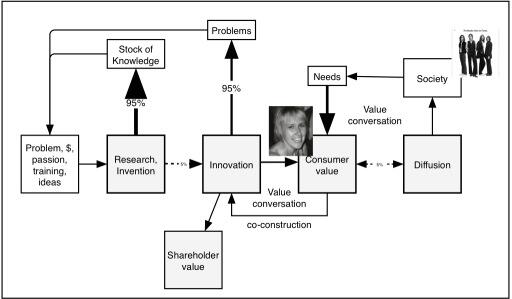 I am currently studying two courses on Coursera. One is about the micro - individual consumer decision making; Irrational Behaviour. The second looks at the macro - Innovation policy in China; Science, Technology and Society in China This weeks assignment asked students to postulate a better version of the linear model of innovation:
I am currently studying two courses on Coursera. One is about the micro - individual consumer decision making; Irrational Behaviour. The second looks at the macro - Innovation policy in China; Science, Technology and Society in China This weeks assignment asked students to postulate a better version of the linear model of innovation:
The Course version of the linear model: basic research -> applied research -> development > testing -> commercialisation
I prefer a simpler version of the linear model: research/invention -> innovation -> diffusion. Long ago, I posted an extension to the linear model include value, titled 'Where does value fit in innovation?'.
On reflection, I have updated my thinking to
propose a modified linear model, I recently tweeted:

My 500 word essay - Draft 1:
My alternative to the linear model
My model (pic.twitter.com/QuEySdFzkY) adds three new features to the linear model; which I summarise as research (new knowledge, basic and applied) -> innovation (new products, development and testing) -> diffusion (spread of products or commercialisation).
- Firstly and most importantly, it adds indications of the level of divergence from the linear path, suggesting most research doesn't create products, and most new products don't succeed in the marketplace. Success is uncommon.
- The second new feature is the model shows what happens as an alternate to succes, and adds two new activities; adding to the 'body of knowledge', for research that doesn't create products, and 'problems' for innovations which are not successful.
- Thirdly and lastly, between the last two phases; innovation and diffusion or as the lecture says between testing and commercialisation, I add a new assessment activity I call consumer value. Consumers judge the value of an innovation both before in choosing and after using a new product. The chance for a new product to spread depends on a favourable recommendation from early users.
- Minor changes also include loops back to research, and society affecting a consumer's needs.
Conceptual Differences - how my model is different in theory
The linear model is a one way model, with no alternate paths, and no feedback loops. My model adds both feedback loops and new stocks of problems and knowledge which result from getting off the linear path, which can restart the research process. Research is both science creating new knowledge and practical problem solving in industry.
Operational Differences - how my model is different in practice
My model shows innovations can arise from consumer pull, from solving innovation problems, as well as from science push. This is consistent with von Hippels' finding in his book "Sources of Innovation" (1988) that much innovation comes from solving business problems, rather than from science.
I commend this rework of the linear model of innovation for your consideration.





